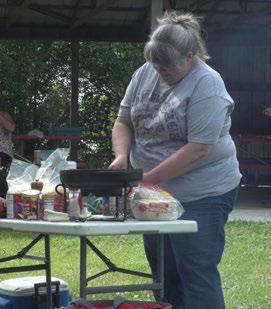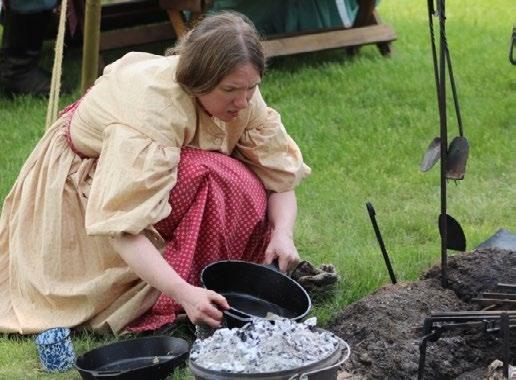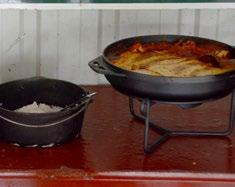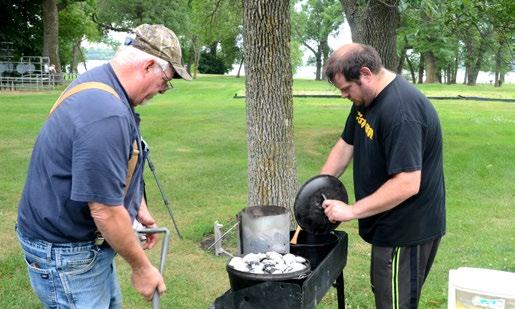
9 minute read
HISTORY OF DUTCH OVEN COOKING BY MELISSA HAMERSMA SIEVERS
Cast iron dutch ovens are a versatile piece of cookware. They can be placed over open fire as a mode of stewing dishes. Alternately, coals or wood embers may be used.
Karri Kreger prepares enchiladas in her dutch oven. Possibilities are endless, savory or sweet.

Karri Kreger has a stack of cast iron cookware in her kitchen cupboards. Once a Girl Scout leader, Kreger brought Dutch ovens along on campouts. At home, the yard is an appealing setting for meal preparation. “I have the whole setup on my patio,” says Kreger. “At least twice a week we’re eating out of the Dutch oven on the back patio, or I use a charcoal grill. I have a smoker, so we eat a lot outside.”
Gwen McCausland has been using Dutch ovens since she was about 12-years old. “I loved reading about history,” says McCausland. “I was just absolutely fascinated. I used to watch Little House on the Prairie on TV.” Rooted in a desire to be selfsufficient and connected to the land, young Gwen honed life skills using primitive techniques. “At that same time I was learning how to spin wool, because I read a book called Hatchet. This kid is flying to Alaska. The plane goes down and he’s living out in the middle of nowhere.”
McCausland explored her family’s farm to learn how to be a self-supporting individual. “My parents were great about letting me dig a pit in the backyard. I would experiment. I already knew how to bake in a normal oven or modern oven. So, we would make biscuits and bread and pies to perfect the technique.”
Embracing resiliency and history inspires McCausland’s hobbies and even her profession. Continued on the next page. Return to Menu
Carey Holt and his wife assemble ingredients for their dutch oven dish, Fiesta Chicken.

Dutch Oven History Continued She presents historical cooking demonstrations with reenacting groups and as part of her role as director of the South Dakota Agricultural Her- itage Museum.
Connecting with history also inspires Kreger to use Dutch ovens. “I think that’s pretty much the niche crowd, people who enjoy being outside and the old way of doing things. When I look at Dutch oven cooking, I think this is what my grandparents did or about the old West.”.
Kreger participates regularly in a potluck-style gathering with friends in Clear Lake. Much of the meal is prepared in Dutch ovens. Carey Holt is an active participant and past scout leader too. For him, flexibility is an appealing element of the cooking method. “You can use wood for heat. You can use charcoal for heat. The ingredients generally are very easily to pack in and pack out because their nonperishable stuff generally is what you use for the cooking.”
Flexibility is one of the reasons why the implement was invented. McCausland has spent time studying its history. Iron casting evolved in the Netherlands with the invention of casting iron using sand. This allowed metal workers to create a high-quality kettle with a tight fitting lid, i.e., the Dutch oven. A British gentleman, Abraham Darby, observed the method in foundries that he visited and wished to replicate them in Britain. Those Dutch ovens were manufactured and followed settlers to British colonies around the world. “Most of those Dutch ovens are just like a kettle with a lid,” says McCausland. “And it has a handle that you could either hang over open fire in a hearth, or you could place over an open fire with a grid or a griddle.”
Innovation continued as the kettle travelled West and through the American colonies. Scholars credit Paul Revere with adding the feet to the cast iron and creating a flat-top lid. McCausland says that this creates a viable baking option. “If you were of a poor family or your house just didn’t have an oven, you could bake using a Dutch oven.” The lip on the lid holds the coals without falling off. The feet allowed placement of coals underneath. An even coating of coals on top and a bellow is what makes it an actual oven.
“You can also use that same Dutch oven as a roaster, the lid as a frying pan. There are many different uses for this one particular cookware. And so that’s why it was very, very popular in the remote areas of the American colonies and Australia. One investment of one piece of cookware could then have multiple uses,” says McCausland. Return to Menu
Dutch Oven History Continued
Installing an earthen oven or brick oven in a home was a very expensive endeavor. Settlers were moving regularly, so a portable mode of baking was more appealing and accessible. Military encampments and cowboys moving cattle found the Dutch oven handy too. “It can be easily be packed up, and doesn’t take up that much room,” says McCausland. “So it was something that was very, very popular in American West. And is technically the official cookware of Texas.”
Currently, the Dutch oven is part of many camping enthusiasts’ kits. Enameled Dutch ovens are often used for casseroles in the modern kitchen. “By the time you actually settled in at your farm or your homestead by the late 1800s, you started getting your cookstoves,” says McCausland. “It wasn’t necessarily used for baking as much as it was for just as a regular roasting pan.” McCausland says that using burning embers around cast iron just isn’t efficient enough to use regularly. “The challenge of baking today is that you have to have a pretty good supply of coals to then heat it. So the average family is not going to wait two or two hours or so to burn down the wood to get the coals.”
Most people don’t saunter out to the yard to set up a fire for their family meal, but Kerri Kreger does. “When the kids are home, they’re outside with the dogs. This way we’re just all outside together.”
Kreger and her friend Carey Holt set up the Dutch Oven Gathering in Clear Lake. For them, the appeal is taking a moment to slow down and connect with their guests. The group has yet to repeat a recipe. Anything can be prepared in a camp oven. Holt enjoys preparing and sharing what he calls Dutch Oven Nachos. “We had this big Dutch oven here that was plum full of that stuff, and there was nothing left at the end of the day. It’s a recipe that is easy to put together and you can sit back and visit while it is cooking and not have to worry about it.”
McCausland agrees that there’s just something about cooking with cast iron, whether it be a pan or oven. “You just get that really nice sear on your meat. And, it really just helps sealing that flavor that I find you don’t necessarily get with other cookware.”
On the other hand, cast iron can be unwieldy. Many folks look past this and are drawn in by an element of nostalgia. “With any cookware, it’s more about the memories that are associated with it and not necessarily the piece itself,” says McCausland. “I would say probably by the 1920s cast-iron went out-of-favor for enamel pans because cast iron is very heavy. If your grandmother always made the best fried chicken out of her heavy cast iron, you need a really strong wrist when you’re having to lift things. Whether you inherited the piece or not, for a lot of people that cast iron is used as a decoration because it’s more of a representation of a family member that lives on through those memories of that piece.” Continued on the next page.

Gwen McCausland demonstrates dutch oven cooking at Fort Sisseton.
Dutch Oven History Continued
But for every challenge there is someone who truly appreciates the extra character. Where some see a heavy piece of cookware, others revere its sturdiness. Cast iron is hearty, holds its heat well and, if cared for, will last generations. Kreger treasures pieces given to her by her mother-in-law who received them from her own grandparents.
Dustin Mattson is another member of the Dutch Oven Gathering. New to the group, he’s still learning to cook over fire with a Dutch oven, but he has some well-seasoned pieces. “I actually have a pot that was given to me, passed down from my great, great grandmother. It wasn’t big enough for our dish today. So, we got one that’ll accommodate enough food for everybody here. I’m using a cast iron skillet that came from my great-grandmother for my side dish. So, continuing to use that, that’s kind of fun.”
Carey Holt remembers desserts made by his grandmother when he uses the heirloom Dutch oven once owned by her. “My Grandma Holt, she made cobbler. That was her famous thing to make, an apple or peach or cherry cobbler in her Dutch oven.”
History in a dinner dish is a unique treat to experience. Modern society turns to single use or cast away items so easily. The idea of using a kettle that pre-dates the cook’s life is astounding. The cookware’s longevity boils down to how a family’s cast iron Dutch oven was cared for. Treated well, it will serve meals for many generations. Just like the vessel, the process is simple. Soap is frowned upon. Hot water and a good scrubbing is enough
“And in the old days, they used to clean their pots and pans, they would make gravy,” says McCausland. “That was how you clean the gristle and bits off of your pan. If there was a buildup, they would just throw it in the fire and let the grease and everything cook off.”
Feeding family and friends a hearty meal has been the purpose of the Dutch oven since it was created. That’s how it was for chuckwagon chefs on a cattle drive, cooks in a military encampment or families making their way across the prairie. Today, it’s a slowed down process of preparing food and a chance to visit with people that you care about. That’s the appeal for Kreger. “I like the process of cooking outside on a fire, being out here with everybody. I like the process of getting stuff together. A lot of it [the cooking technique] is timing and when to turn your pots. My goal at the end is to have a pot of food when we’re ready to have supper.”
Then at evening’s end you wipe out the kettle and stash it away. It’s ready for the next gathering.
Extra: Tips for baking pie in a dutch oven.

Carey Holt enjoys using coals for dutch oven cooking.





